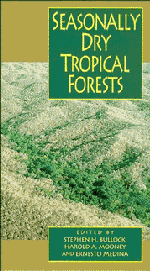Book contents
- Frontmatter
- Contents
- List of contributors
- Acknowledgements
- 1 Introduction
- 2 Dry forests of Central America and the Caribbean
- 3 Overview of the Brazilian caatinga
- 4 Savannas, woodlands and dry forests in Africa
- 5 Dry forest ecosystems of Thailand
- 6 The Cenozoic record of tropical dry forest in northern Latin America and the southern United States
- 7 Diversity and floristic composition of neotropical dry forests
- 8 Vertebrate diversity, ecology and conservation in neotropical dry forests
- 9 Diversity of life forms of higher plants in neotropical dry forests
- 10 Drought responses of neotropical dry forest trees
- 11 Plant reproduction in neotropical dry forests
- 12 Plant–herbivore interactions in Mesoamerican tropical dry forests
- 13 Biomass distribution and primary productivity of tropical dry forests
- 14 Nutrient cycling in tropical deciduous forests
- 15 Biology of the belowground system of tropical dry forests
- 16 Nitrogen trace gas emissions in a tropical dry forest ecosystem
- 17 Conversion of tropical dry forest to pasture and agriculture
- 18 Ethnobotany of the Mexican tropical dry forests
- Index
9 - Diversity of life forms of higher plants in neotropical dry forests
Published online by Cambridge University Press: 07 September 2010
- Frontmatter
- Contents
- List of contributors
- Acknowledgements
- 1 Introduction
- 2 Dry forests of Central America and the Caribbean
- 3 Overview of the Brazilian caatinga
- 4 Savannas, woodlands and dry forests in Africa
- 5 Dry forest ecosystems of Thailand
- 6 The Cenozoic record of tropical dry forest in northern Latin America and the southern United States
- 7 Diversity and floristic composition of neotropical dry forests
- 8 Vertebrate diversity, ecology and conservation in neotropical dry forests
- 9 Diversity of life forms of higher plants in neotropical dry forests
- 10 Drought responses of neotropical dry forest trees
- 11 Plant reproduction in neotropical dry forests
- 12 Plant–herbivore interactions in Mesoamerican tropical dry forests
- 13 Biomass distribution and primary productivity of tropical dry forests
- 14 Nutrient cycling in tropical deciduous forests
- 15 Biology of the belowground system of tropical dry forests
- 16 Nitrogen trace gas emissions in a tropical dry forest ecosystem
- 17 Conversion of tropical dry forest to pasture and agriculture
- 18 Ethnobotany of the Mexican tropical dry forests
- Index
Summary
Introduction
Tropical dry forests constitute a large set of plant communities occurring under climates characterized by highly seasonal distribution of rainfall (Murphy & Lugo, 1986). The actual percentage of deciduous woody components varies from 100% to 40% depending on the specific forest type and its location within the rainfall gradient (Beard, 1955; Sarmiento, 1972; Hegner, 1979; Mateucci, 1987). In general it is assumed that along a gradient of rainfall in the lowland tropics, under similar temperature conditions, the proportion of deciduous woody components increases more or less linearly as the amount of rainfall received per year decreases below about 2000 mm (Walter, 1973). The structure of the community changes along these rainfall gradients in terms of community height, density of ground cover, proportion of trees and shrubs, and the occurrence of lianas, epiphytes and hemiparasites. The functional attributes of the structural components also change more or less monotonously along the gradients, thus the proportion of deciduous trees and shrubs tends to increase, the presence of epiphytes and hemiparasites is reduced, and at certain levels of the gradient the lianas (woody climbing plants) are important. Along the same gradients the proportion of succulent plants, including Crassulacean acid metabolism (CAM) performing cacti and stem succulent, drought deciduous trees, increases. A growth form showing dominance toward both extremes of the rainfall gradient is the evergreen type of woody plants. The evergreens at each extreme, however, may be separated according to their leaf structure and drought resistance. In this review I will discuss the differentiation of plant components in neotropical dry forests according to morphological and eco-physiological features.
- Type
- Chapter
- Information
- Seasonally Dry Tropical Forests , pp. 221 - 242Publisher: Cambridge University PressPrint publication year: 1995
- 38
- Cited by

